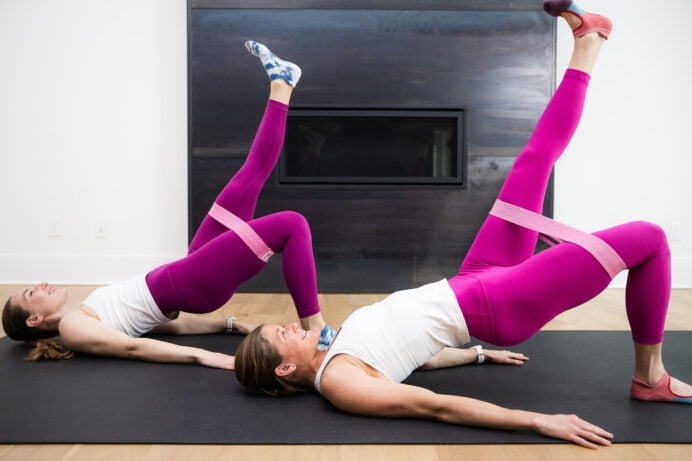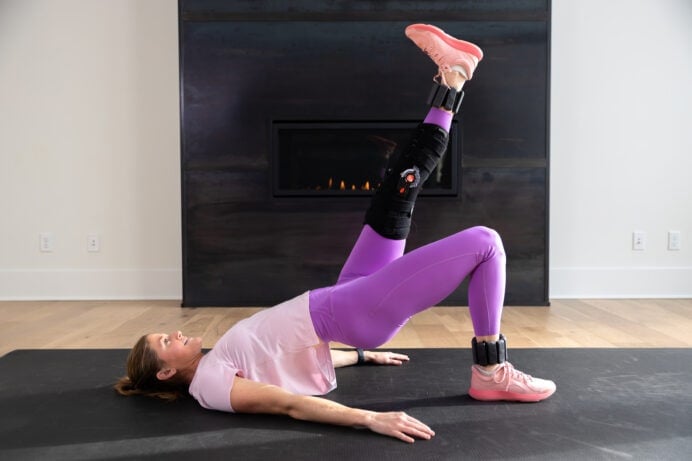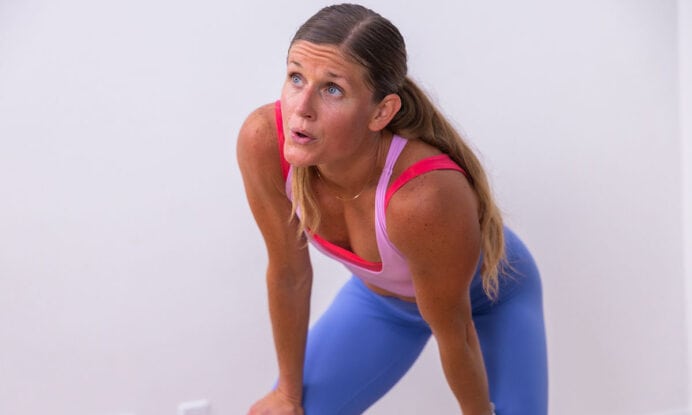

5 Best Knee Strengthening Exercises At Home
Five of the best knee strengthening exercises to reduce pain, increase strength, and improve mobility. Knee strengthening workouts are a great way to improve the health and functionality of your knees. Whether you’re recovering from a knee injury, looking to improve athletic performance, or want to reduce future risk of injury, these knee strengthening exercises at home are an excellent addition to your fitness routine.
Build stronger, more resilient knees with these knee strengthening exercises.
This knee strengthening workout is designed to both strengthen the muscles that support the knee joint (including the quadriceps muscles, glute muscles, calf muscles and hamstring muscles) as well as increase flexibility and mobility around the knee and ankle joints.
Whether you’re recovering from an injury, are a runner who suffers from knee pain, or just want to proactively protect your knees, these five exercises are beneficial to add to your fitness routine.
I started adding these exercises to my training routine following a torn meniscus injury and meniscus surgery. I worked with a physical therapist in person and also followed the “Knees Over Toes” exercise program (Athletic Truths Group) and found both extremely helpful.
If lunges and squats hurt your knees, these knee strengthening exercises may help. I’d also recommend these lunge and squat alternatives.


5 Best Knee Strengthening Exercises
Walking Backwards
Purpose: Walking backwards strengthens the Vastus Medialis Oblique (VMO) muscle, or the teardrop shaped muscle on the inside of your quad (front of thigh). This fast-twitch muscle helps move the knee joint and stabilizes the kneecap.

How To Walk Backwards
- You can walk backwards on a treadmill, outside or just around your house.
- Find a safe and clear space. Make sure you have enough space to walk without bumping into anything or anyone. Keep your head up and eyes looking forward to avoid tripping or falling.
- Keep your knees slightly bent as you begin walking backwards, alternating stepping one foot behind the other. This will help with balance and stability.
- As you become more comfortable, increase stride length, speed and incline to increase the challenge.
Tibialis Raises (Tib Raises)
Purpose: Tib raises strengthen the tibialis anterior muscle, or muscle along the front of the shin (lower leg). This is the primary shock absorber of the knee, and strengthening this muscle can help protect both the knees and ankles.

How To Do Tib Raises
- Start standing on a flat surface, feet shoulder-width apart, leaning against a wall. Step your feet out 3-4 inches away from the wall, keeping your back pressed against the wall.
- Slowly lift your toes towards your shins while keeping your heels on the ground.
- Hold for a second, before slowly lowering your toes to tap the ground, returning to starting position.
Knees Over Toes Calf Raises
Purpose: This variation of a standard calf raise both strengthens the calf muscles (muscles along the back of your lower legs) and improves ankle mobility. Increasing the flexion (pushing knees over toes) is a functional training movement. This exercise supports your knees, ankles and achilles through acceleration/deceleration movements and shock absorption from impact.

How To Do Knees Over Toes Calf Raises
- Start standing, feet shoulder-width apart and toes pointing forward. Option to place hands on a chair or countertop for additional balance support.
- Shift your weight forward so that your knees move over your toes. Keep your back straight and your core engaged.
- Slowly raise your heels, balancing on your toes (maintaining a slight bend in your knees).
- With control, slowly lower your heels back down to the ground, returning to starting position.
Modification: If the knees over toes position isn’t comfortable, perform standard calf raises.
Step Downs
Purpose: Step downs increase knee range of motion and strengthen the VMO (vastus medialis oblique) muscle. The VMO is the first of your quad muscles to contract when the knee is under load – which means that strengthening it is beneficial for protecting knees from impact.
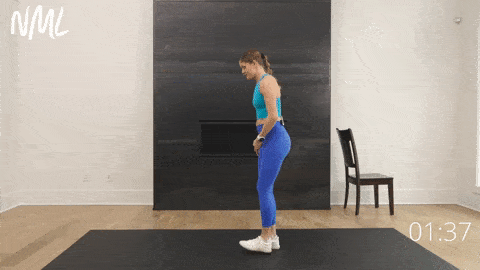
How To Do Step Downs
- Start standing, feet hip-width apart and planted on the ground.
- Keep your right foot planted on the mat and kickstand your left foot in front of you, toes pointing up.
- Keeping your left leg straight, slowly bend your right knee and lower your hips as you tap your left foot out in front of you. Think of performing a half squat on your right leg. Strive to get your right knee over your right toes, while keeping your right heel planted on the ground.
- Straighten your right knee, returning to a standing position as you pull your left leg back in to meet the right.
Glute Bridges
Purpose: Glute bridges strengthen the muscles that are important for knee stability, and can be performed without putting excessive stress on the knee joint. Glute bridges strengthen behind the knees, which is important for preventing knee injury.
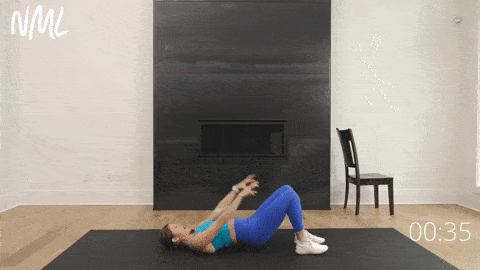
How To Do Glute Bridges
- Lie flat on your back with knees bent and feet flat on the floor.
- Drive through your heels, squeezing your butt to lift your hips up toward the ceiling. Keep knees in line with hips
- Hold at the top for a moment, then slowly lower your hips down, hovering just above the mat.
5 Best Knee Strengthening Exercises At Home
The five best exercises to build strong knees at home. These exercises combine bodyweight strength knee exercises with functional knee stretches to prevent injury and reduce knee pain.
Add mobility training like this to your home training program 2-3 times a week to improve athletic performance, reduce pain and prevent knee injuries.
Workout Equipment:
No Equipment Needed (Bodyweight Only). Option to add a chair/countertop to hold on to for balance support.
Workout Instructions:
Follow along with the guided Knee Rehab Workout video on YouTube, led by certified personal trainer, Lindsey Bomgren.
Your Workout Looks Like This:
- 5 Knee Strengthening Exercises
- Timed Intervals (perform each move for 40 seconds, followed by 20 seconds rest)
- No Repeats (perform each knee exercise x1 set)

Prefer to Watch On YouTube?
 Knee Workout
Knee Workout
Workout Outline
- Walk Backwards
- Tibialis Raises
- Knees Over Toes Calf Raises
- Step Downs
- Glute Bridges
Knee Strengthening Exercises FAQs
The best way to strengthen the knees is a combination of building muscle around the knee joint and increasing joint mobility. This is commonly done through extension exercises (kicking the leg out) and flexion exercises (bending the knee).
Step downs, glute bridges, calf raises and tibialis raises are some of the best knee exercises. These exercises strengthen the leg muscles, thigh muscles, calf muscles, and hip muscles surrounding the ankle and knee joints.
Walking is a low impact exercise that strengthens the muscles surrounding the knees without excessive impact. Walking backwards is even more beneficial for strengthening the knees and can help relieve pain surrounding the knees.
Strengthening the muscles around your knees can help reduce the risk of injuries such as sprains, strains and tears.
Rest is extremely important, especially in the early stages of an injury. Once you are ready to resume exercise, begin with one of our Leg/Knee Injury Workouts or Seated Workouts.
More Workouts
Knee-Friendly WorkoutsPin this: Knee Strengthening Exercises At Home

This post includes affiliate links. I do make a small commission for products purchased using these links (at no additional cost to you). Thank you for supporting Nourish Move Love, making the content you see on this blog possible.











